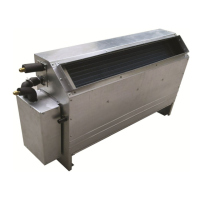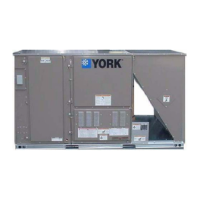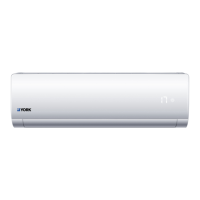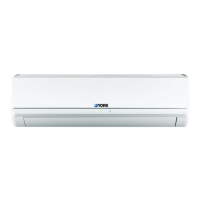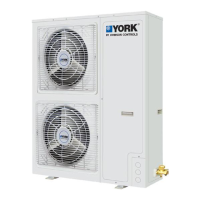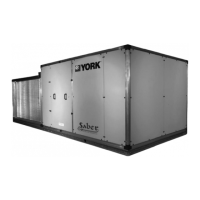115
JOHNSON CONTROLS
FORM 145.05-NOM1 (708)
TABLE 26 – HUMIDITY SENSOR OUTPUT
RELATIVE
HUMIDITY
MA OUTPUT
RELATIVE
HUMIDITY
MA OUTPUT
0 4 55 12.8
5 4.8 60 13.6
10 5.6 65 14.4
15 6.4 70 15.2
20 7.2 75 16.0
25 8.0 80 16.8
30 8.8 85 17.6
35 9.6 90 18.4
40 10.4 95 19.2
45 11.2 100 20.0
50 12.0
FAULTS AND ALARMS
A “Fault” is declared when an abnormal operation is
detected. Usually this is related to a parameter operating
outside the accepted range, for example the discharge
pressure being above the discharge pressure high-
pressure limit. A “Fault” may result in a temporary
shutdown of a system or the unit; however, when the
“Fault” condition is corrected the unit returns too
normal operation. The control will also close a contact
and turn on the LED at DO1 on the control board. This
set of dry contacts could be used to energize an external
device to alert the user that a “Fault” or “Alarm” is
present.
An “Alarm” will require intervention to reset the unit.
Multiple “Faults” in a given time frame can result in
the initiation of an “Alarm”. An “Alarm” will result in
the lockout of the unit or one of its operating systems.
When an “Alarm” is present, the “Alarm” light will
illuminate on the Keypad / Display. The control will
also close a contact and turn on the LED at DO1 on the
control board. This set of dry contacts could be used
to energize an external device to alert the user that an
“Alarm” is present. An “Alarm” can be reset in two
ways:
• Removing the 24-volt input to the control. This
can be done by moving the slide switch in the
bottom right hand corner of the control to OFF,
and then back ON.
• The second method is through the Keypad / Dis-
play. Press the right arrow key > until the display
shows [Faults] and press ENTER, use the right
arrow key > to scroll down to “Off – On Resets”.
Press ENTER. You will be asked to enter the
password. Enter the password and press ENTER.
Use the INC key to change OFF to ON and press
ENTER. The “Alarm” will reset. Press ENTER
and then INC to turn the “Off – On Resets” back
to OFF.
Compressor High Pressure (Fault / Alarm)
The control monitors the discharge pressure for each of
the compressors. This analog (0 to 5 volt) input can be
found on the Auxiliary I/O control board as follows:
Compressor A – IN-1 terminals 1 and 2
Compressor B – IN-3 terminals 5 and 6
Compressor C – IN-5 terminals 9 and 10
Compressor D – IN-7 terminals 13 and 14
If the analog input exceeds 4 Volts DC (350 psig), the
control will terminate compressor operation for the
compressor with the high pressure. The control will
keep the compressor off line for five minutes after the
discharge pressure has fallen below 250 psig. The
control will register a “Comp # HP Fault” until the
pressure is below 250 psig for five minutes. Where #
can be compressor A, B, C, or D. The control maintains
a running total of the number of times the Discharge
Pressure exceeds the 350 psig setting for each system.
Each time the Discharge Pressure exceeds the 350 psig
setting the counter increases by one. Every hour the
control decreases the fault count by one. The current
condition of the “Fault” (ON – active / OFF – inactive)
and the current count can be viewed using the Keypad /
Display. Use the right arrow key > to scroll to “Faults”
and press the ENTER key. Press the right arrow key >
to scroll down to “Comp # Hi Pres”. The display will
tell you Off or On and # Trips. If the accumulated fault
count reaches five the control will declare a “Comp #
HP Alarm”. The control then locks out the operation
of the compressor system with the Alarm.
Compressor Low Pressure (Fault / Alarm)
The control monitors the suction pressure for each of
the compressors. This analog (0 to 5 volt) input can be
found on the Auxiliary I/O control board as follows:
Compressor A – IN-2 terminals 3 and 4
Compressor B – IN-4 terminals 7 and 8
Compressor C – IN-6 terminals 11 and 12
Compressor D – IN-8 terminals 15 and 16
8
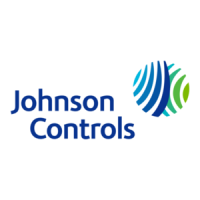
